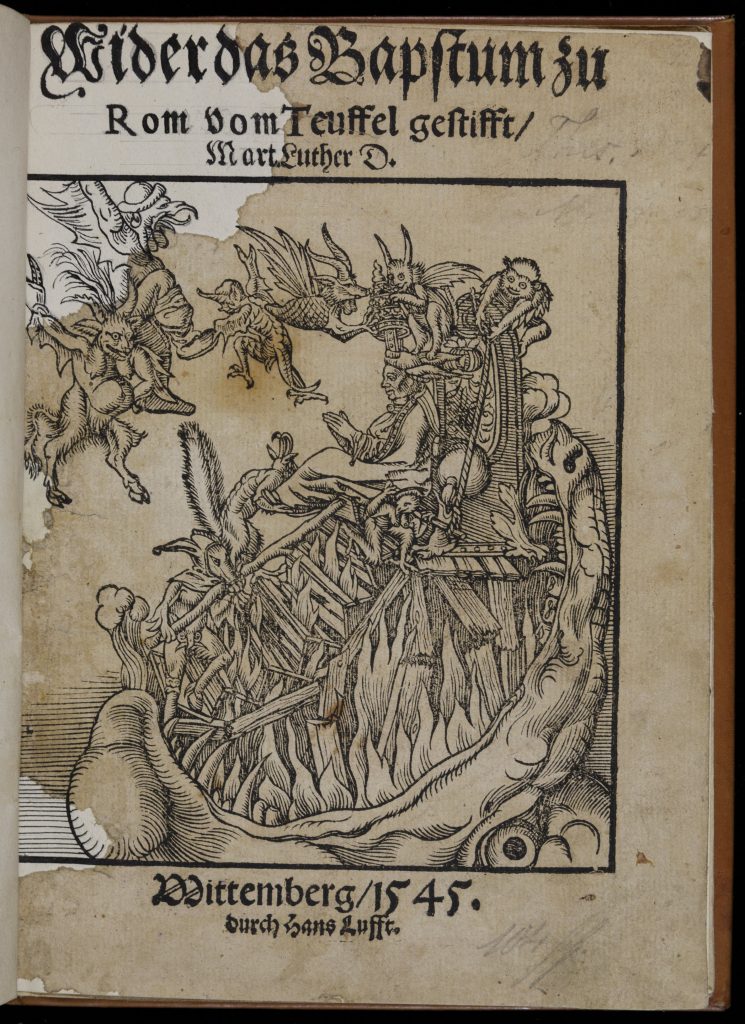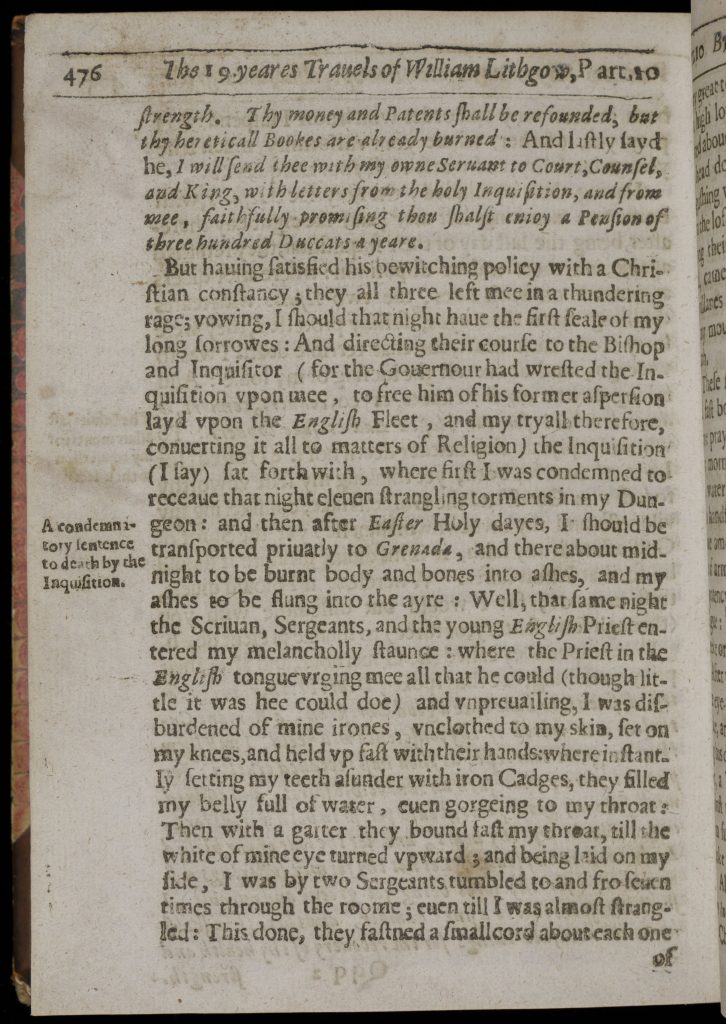
Originally established in the 13th century to combat heretical groups, the Inquisition became a sophisticated, global operation in the early modern period.
Originally published by Newberry Digital Collections for the Classroom, 06.15.2018, Newberry Library, republished with permission for educational, non-commercial purposes.
Introduction
From movies to metal bands to Monty Python (“Nobody expects the Spanish Inquisition!”), the Holy Office of the Inquisition has retained a powerful place in popular imagination. For many, this image is of a shadowy, malevolent force of repression and violence, one of the most notorious legacies of premodern European society. Without question, the Inquisition exacted a terrible toll: from the 15th to the 19th centuries, tens of thousands of people – many of them Jews – were executed after being condemned by the Inquisition, and hundreds of thousands more were prosecuted, imprisoned, and impoverished.
However, the story behind the Inquisition – its origins, its methods, and its impacts – is more complex than its popular legend. Originally established in the 13th century to combat heretical groups in France and Germany, the Inquisition only became a sophisticated, global operation in the early modern period. Starting with the Spanish Inquisition’s increasing prosecution of converted Jews in 1478, the Inquisition was tasked with managing the Roman Church’s response to a rapidly changing world.
Not surprisingly, the Inquisition was not the same everywhere. The three official offices of the Inquisition – in Spain, Portugal, and Rome – were established at different times for different purposes, and to varying degrees of success. The legend of the Inquisition has obscured how these national Inquisitions did their work, why they took the actions that they did, and how their enemies in Protestant lands helped ensure their lasting legacy.
The documents and images below provide a broad overview of the Inquisition, both its reality and its legend. Together, they will help explain how the paragon of premodern intolerance was, in many ways, accidentally shaped by larger cultural forces – religious change, the development of print culture, and the creation of a global society – that helped transform the medieval world into the modern one.
The Inquisition Expands


The Inquisition gained a greater degree of urgency in the early 16th century, when Martin Luther led the most powerful challenge to the Roman Church’s spiritual authority in a millennium. Luther advocated for a different approach to salvation – through faith, the reading of Scripture, and the end of Rome’s authority over church practice and belief – that found widespread approval and support. His chief weapon in this effort was the printing press, which, he realized, was able to bring his ideas to a large audience quickly. Luther launched a carefully coordinated mass media campaign against the Roman church, producing a range of printed works using every possible method of reaching out to the general public. Many of these works were written in German, which brought his ideas to a much larger audience. The important pamphlet Address to the German Nobility, for example, was designed to recruit the German princes to Luther’s spiritual cause. Many of these works also used images to attack his Catholic opponents, such as this striking woodcut of an enthroned pope being swallowed by the mouth of hell in his pamphlet, Against the Papacy in Rome Founded by the Devil.
The Inquisition and Print



When Catholics finally mobilized a concerted effort against spread of Protestantism in the mid-16th century, the newly-constituted Roman Inquisition played a leading role. Inquisitors were convinced that controlling the printing industry was essential to their work. Throughout Italy, Spain, and the Low Countries, they prosecuted not only authors of Protestant books, pamphlets, and broadsides, but also anyone who printed, sold, and owned them. Catholic authorities circulated lists of officially banned authors and books so that printers and the general public would be aware of them. These lists were later subsumed in 1559 by the first Index of Prohibited Books, an official catalog of dangerous literature that also included guidelines for pre-publication censorship and the regulation of the printing industry. In addition to Protestant authors like Luther, the Index targeted books that were only partially problematic, clarifying which portions should be avoided. The owner of this copy of Erasmus’s popular Adages took this advice to heart, and dutifully crossed and cut out the “erroneous” material in the book. By the 17th century, authors in Catholic lands had to consult inquisitorial officials to produce “safe” books. Galileo Galilei even took this route, working for years to produce a version of his infamous book comparing the Copernican and Ptolemaic solar systems that would pass muster with the Inquisition.
The Inquisitorial Process



There was nothing haphazard about the Inquisition. Wherever it operated, the office of the Inquisition was among the most sophisticated and orderly institutions in the early modern world. Inquisitors pursued their work according to certain procedures that circulated in print and in manuscript, and were frequently updated as the offices and the problems they encountered developed. The need to stay current might explain the production of this manuscript copy of Instructions that Inquisitors Must Follow. At every point, trials and examinations of alleged heretics were formal legal proceedings with carefully-defined vocabulary. The passage from the printed inquisitor’s manual below, for instance, lays out the precise understanding of the key term “heresy.” In Spain and Portugal (but not in Rome), the inquisitorial process for those condemned for heresy ended in an auto de fe (act of faith), an elaborate public ceremony designed to celebrate orthodox faith while simultaneously shaming and punishing those who violated it. All condemned heretics (even those who confessed and reconciled with the church) were dressed in humiliating costumes and marched through a city to a public square, where they would be sentenced and, if necessary, executed after a public service. The image here, taken from an illustrated history of the Inquisition, depicts the accused sitting on a special stage while a preacher condemns them. Inquisitors encouraged the orthodox public to attend these events by holding them on feast days (when no one worked) in the public center of the city, and by offering spiritual benefits to those who attended.
The Global Inquisition



As the Catholic Church spread to the Americas, Africa, and Asia through conquest and colonization, the Inquisition went with it. Inquisitorial offices and tribunals were quickly set up from Brazil and Mexico to India and the Philippines in order to “protect” new converts from Jews, Protestants, and those who still practiced indigenous religions. This was no easy task; inquisitors in the colonies had to navigate a more diverse religious environment than in Europe, a tricky process described in Gabriel Dellon’s account of the Portuguese inquisition in India. To overcome these challenges, the international branches generally followed the same procedures as their European counterparts, including controlling the printing industry. Inquisitors in Mexico had the authority to review and approve books for publication; four inquisitors reviewed (and approved) this petition to print an astronomical almanac for the year 1656. These officials also censored books brought over to the colonies from Europe, a fate that befell this prayer book in 1571.
The Legend of the Inquisition


Ironically, the lasting cultural power of the Inquisition today is in large part due to Protestants, especially those living in the Netherlands and England, two Protestant powers fearful of Spanish expansion. The Inquisition was a key aspect of a massive propaganda campaign by the English and Dutch to prove the inherent corruption and wickedness of their Catholic rivals. William of Orange, an important early leader of the Dutch war for independence from Spain in the late 16th century, cited the threat of an Inquisition – which he called “the greatest crime that can be in Spaine” – coming to France and the Low Countries as the factor that drove him to rebellion. Narrative accounts of individuals who were imprisoned or tortured by the Inquisition were a particularly useful genre for perpetrating horror stories (true as well as false) about the Inquisition. These texts were often best-sellers in Protestant lands, especially England, where interest in texts like this was especially high. A typical English perspective on the Spanish Inquisition was offered by the traveler William Lithgow, who claimed to have been unjustly arrested, tortured, and nearly burned by the Inquisition while traveling in Spain.
Selected Sources
- MacCulloch, Diarmaid. The Reformation: A History. New York: Viking, 2004.
- Kamen, Henry. The Spanish Inquisition: A Historial Revision. New Haven, CT: Yale University Press, 1997.
- Lea, Henry Charles. A History of the Inquisition in Spain. 4 vols. New York, 1906-1908.
- Greenleaf, Richard. The Mexican Inquisition of the Sixteenth Century. Albuquerque, 1969.
By Dr. Christopher Fletcher
Head Researcher, Medieval Scientific History
Centre national de la recherche scientifique







